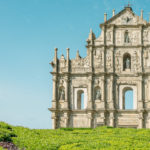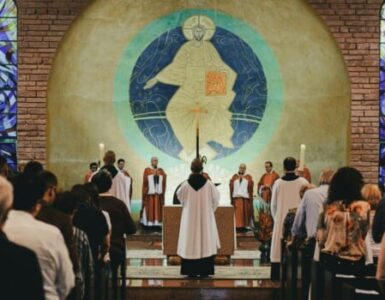As in the case of subsidiarity, also the idea of inculturation was practiced by the Church for centuries before being explicitly articulated and defined in more abstract terms. Arguably, St. Paul’s preaching and writing was already a model of inculturation. Simply put, inculturation is a cautious adaptability that missionaries deploy when presenting the Catholic Faith in the context of specific cultures and human societies. It is a difficult balancing act, because of course even when we adapt the presentation of the Gospel we can never betray it. In other words, inculturation is not about skipping or rewriting parts of the Faith that appear hard to comprehend or accept in a given century and place. Rather, inculturation is based on two observations. First, every culture contains at least some elements of truth and beauty that prepare it for the Gospel: these can be some moral values matching the Natural Law, or even beliefs about God and the human soul. Second, every culture expresses itself in languages, symbols, traditions, social orders, and patterns of daily life that are morally neutral, but that Christian missionaries need to study, respect, and make use of as they embark on the task of evangelization.
The extraordinary life of Matteo Ricci embodies the genius and the challenges of inculturation in the key decades following the age of exploration. Between the voyages of Christopher Columbus and Vasco da Gama in the 1490s and the opening of a return route across the Pacific Ocean in the 1560s, the Catholic Faith moved from a claim to universality that had mostly existed in potency to the actuality of a global Church that necessitated missionary efforts on a breathtaking scale. Ricci was born in 1552 in the peaceful Italian town of Macerata, surrounded by colorful hills and farms but also graced by the presence of a Jesuit school. The Society of Jesus (the Jesuits’ formal name) had recently been approved by Pope Paul III, and soon became the most important order of the Counter-Reformation, or Catholic Reformation. After moving to Rome, where he studied at the Jesuit Collegio Romano under the supervision of the great German mathematician Christopher Clavius, the young Ricci realized that he had a vocation for the priesthood and a strong desire to visit “the Indies.” While his father wished him to become a lawyer, Ricci entered the Jesuit order and filed a request to be sent to Lisbon, which was the first step towards Goa and the Far East.
Jesuit missionaries traveling to the East were not looking at the world according to the dichotomy “European vs other.” In fact, in the decades immediately following its establishment, the Society of Jesus was deployed by the Pope especially within Europe. The fundamental aspect of missionary work in a post-Reformation environment was not the spreading of any civilization but rather the preaching of the Gospel and the defense of Catholic doctrine both within and outside of Europe. Even the dichotomy Catholic-Protestant falls short of grasping the genuine preoccupation of Jesuit missionaries for the salvation of souls, since many of their missions targeted “Catholic” areas of Europe, such as Naples, where the Church realized that the spiritual needs of the population had not been properly taken care of for many decades. Therefore, when the Jesuits reached China, their view of the world as a spiritual landscape cut across racial, linguistic, and political divisions. Entering China in 1582, Matteo Ricci was determined to study the stunning achievements of an ancient, sophisticated civilization to then integrate them with the transcendent teachings of Christ. Of course, this is not to deny that Jesuit missionaries saw their Faith as superior to Eastern religions, but the post-modernist reduction of everything to power structures and political objectives miserably fails to give an accurate account of early modern Catholicism. Suffice it to say here that Jesuit missionaries could consider “successful” a mission where their brethren were martyred (Chile, Japan), or they could defend the autonomy of their missions even at the cost of entering violent conflicts with European imperial authorities (Paraguay). This should suggest that power and politics are not enough to explain reality (let alone history!), because spiritual forces – in this case, the genuine interest felt by Jesuit missionaries towards the salvation of souls – are also pivotal.
Initially, the Jesuits entering China attempted to gain the respect of local elites by dressing like Buddhist monks. Yet, Matteo Ricci soon abandoned this strategy, for two reasons: because he realized that monks were not considered particularly knowledgeable by the Chinese intellectuals; and because he realized that Buddhism was incompatible with Christianity. Instead, Ricci became increasingly interested in the Confucian tradition. He learnt the Chinese language, studied the Confucian canon, and even started to take part in the intellectual life of the country, visiting Chinese scholars in Shaoguan, Nanchang, Nanjing, Peking, Suzhou and other cities, and absorbing the philosophical tradition that they discussed. Ricci demonstrated his ability to engage with this tradition, as he translated the Confucian classics for the first time into Latin and then proceeded to develop an interpretation that recognized in these texts traces of an ancient monotheism. Simultaneously, he became friends with some of the most brilliant writers and intellectuals of Ming China, and he followed a strategy by which he would disseminate scientific ideas and objects while also introducing the basic teachings of the Gospel and baptizing as many members of the Chinese elite as possible. One of the earliest Chinese converts was the agronomist and mathematician Xu Guangqi, who helped Ricci to translate Euclid’s Elements into Chinese, and whose mausoleum has incredibly survived the fury of the Cultural Revolution and can still be visited in central Shanghai. Ricci’s was a realist outlook, which took into consideration the vastness of China and the extremely limited number of Jesuit priests that were available: it would have been impossible at this stage to attempt the conversion of the Chinese people with such limited resources. Rather, Ricci concentrated his efforts on Chinese officers and writers, on the Chinese court, and on the larger cities of the Empire.
Characteristically, while he authored The True Meaning of the Lord of Heaven, which used Confucian concepts and ideas to introduce Christian theology, he was also engaged in the writing of a book in Chinese On Friendship, in the compilation of Portuguese-Chinese dictionaries, in the construction of clocks with which to attract the interest of officers, and in the production of a world map for the Chinese court in which he placed China at the center in order to accommodate a Sinocentric vision of the world. Hence inculturation (in action rather than in the abstract) has a life of its own, and it escapes clear definitions. In 1596 in Jiangxi Province, it took the form of a book on memory, which Ricci took the time to write knowing how important this issue was for the offspring of the Chinese when they prepared for the civil service examination. As a result of this gift to the local governor, Ricci obtained a license that allowed the Jesuits to buy a house in the province.
By condemning Buddhism as an idolatrous influence on the Chinese people, and by praising Confucianism as a beautiful moral system, Ricci gave a perfect example of adaptation and inculturation. On the one hand, not every aspect of Chinese culture was compatible with the Faith, and he did not try to minimize this problem but rather engaged in constant debates with Buddhists. The sins of polygamy and concubinage were another issue on which Ricci boldly and uncompromisingly spoke the truth, even at the cost of delaying or denying baptisms. On the other hand, Ricci reframed Confucianism as a philosophy that contained a positive value system. Confucianism could be retained as a philosophical tradition upon which Christianity would be added: Ana Carolina Hosne has proposed that Ricci saw an overlap between the philosophical and moral truths grasped by Greek and Roman pagans like Cicero and the ideas of virtue and propriety articulated by the Chinese tradition. Still, Ricci’s exaltation of Confucianism was based on a simplification of its internal diversity and on a very generous interpretation of its ritual aspect: according to the Italian Jesuit, Confucianism contained no supernatural teaching, and its rites did not point to transcendent ideas but were merely an expression of social cohesion that rendered visible the bonds between generations and the moral values of China.
Later, when other groups of Catholic missionaries arrived in Macau, they could not believe their eyes as they saw Chinese Catholics who still performed Confucian rites, in particular those rites that could be interpreted as worship of their ancestors. This disagreement among missionaries would cause the famous “Rites Controversy” and is a reminder of the delicate nature – or perhaps even the limits – of inculturation. Yet, it is important to remember that the Jesuits, followed by Dominicans and Franciscans, also baptized tens of thousands of Chinese, gradually expanding their missionary efforts among the common people and into the heartlands of China. Ricci laid the foundations of this success, developing a careful understanding of Chinese civilization and a holistic approach to evangelization. In the decade between Ricci’s death (1610) and the beginning of the “Rites Controversy,” Rome granted the permission to translate the Bible into Chinese and allowed priests in China to cover their heads during the holy sacrifice of the Mass (instead of uncovering them), in keeping with the Chinese idea of covering one’s head to show respect. Furthermore, Ricci’s mission to China engendered one of the most remarkable transfers of knowledge in world history: the Jesuits introduced into China new ideas about the shape of the Earth, new geographic notions including the existence of the American continent, new geometric, mathematical, and astronomical principles. We should remember this important page in the history of the universal Church and feel inspired and challenged by the determination, charity and wit of Ricci and his companions, who rushed to the other side of the world to befriend the Chinese people and to spread the Gospel.
✠














